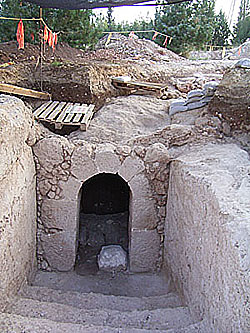A magnificent arch built of large well-dressed stones was uncovered in the excavations. The arch was attached to the side of a ritual bath (miqve) that was discovered there and led to a subterranean chamber. Installations were also discovered that are ascribed to a Jewish settlement that existed there at the time of the Second Temple period, among them a number of ritual baths that were used by the residents in maintaining the halachic practices of purity.

Blocked openings were revealed inside the installations at the site. These raise the possibility that behind them are tunnels similar to the hiding refuges that were discovered in this region in the past. The latter were also dug inside of installations during the time of the Bar Kokhba uprising (132 CE) and were used by the rebels in concealing themselves from the Romans. The openings that were found in this excavation were probably used for a similar purpose, but have not yet been uncovered.
The excavation director has noted that in addition to the discovery of the finds, this excavation clearly shows that the area of the Jewish settlement that was excavated in this region in the past extends across a larger area than was previously believed.
During the excavation a very large amount of pottery sherds was found that date to the Roman, Byzantine and later periods. The vessels include different kinds of oil lamps, jars, cooking pots, amphorae, and juglets. Among the other small finds that were recovered in the excavation are numerous glass vessels, some of which are kinds that were previously unknown from this period, various coins and an object that is believed to be a part of a pendant.
No comments:
Post a Comment